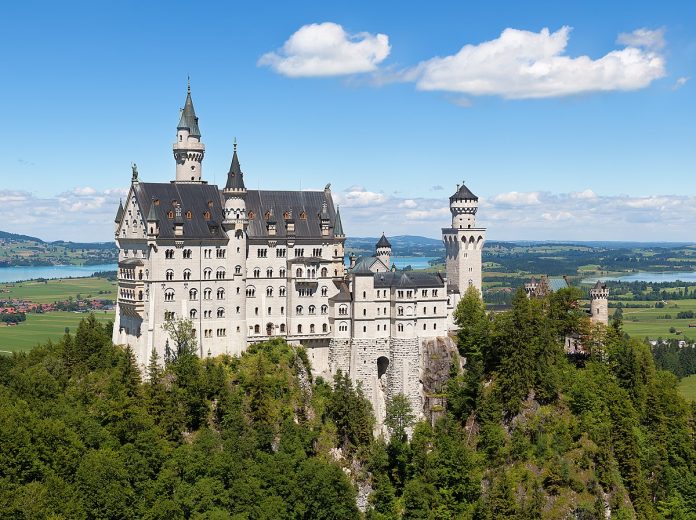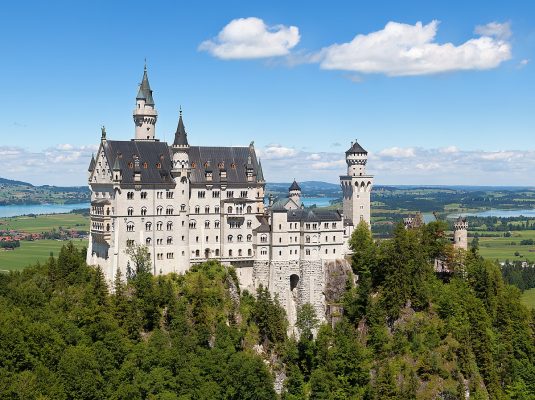Explore the renowned Neuschwanstein Palace in Germany, a fairytale castle located in which region and known for its enchanting design and history as a fairytale castle.
Introducing Neuschwanstein Palace
Neuschwanstein Palace, located near Füssen, Germany, is a stunning and iconic castle that was commissioned by King Ludwig II of Bavaria. Built in the 19th century, the palace is known for its fairy-tale appearance and romanticized medieval design. Despite being left unfinished, it has become one of the most popular tourist attractions in Europe, drawing in millions of visitors each year.
The palace stands on the site of two smaller castles, with construction beginning in 1868. Designed to be a homage to medieval architecture, Neuschwanstein is a paradox of the old and the new, featuring technological comforts such as running water, flush toilets, and central heating, while maintaining a romantic and lavish aesthetic. The interior is adorned with wall paintings depicting the legends that inspired the composer Richard Wagner, whom King Ludwig II was a patron of. The castle’s grandeur and its stunning location in the Bavarian Alps make it a must-see destination for history and architecture enthusiasts.
Importance of the palace in Germany
Neuschwanstein Castle holds great importance in Germany as it represents the romantic ideals and aspirations of King Ludwig II. The castle’s design and construction reflect the king’s vision of a fairy-tale-like palace, inspired by medieval and romantic elements. This architectural masterpiece has become a symbol of German Romanticism and has attracted millions of visitors from around the world, contributing significantly to the country’s tourism industry.
Historical Significance
The construction of Neuschwanstein Castle marked a significant period in German history, reflecting the cultural and artistic aspirations of the 19th century. The castle’s association with King Ludwig II, who was known for his patronage of the arts and his eccentric personality, adds to its historical importance. The castle’s unfinished state at the time of the king’s death also adds an air of mystery and intrigue, further enhancing its historical significance.
The castle’s influence on art and culture is also noteworthy, as it served as a source of inspiration for various artistic works, including literature, music, and film. The castle’s picturesque setting and romantic design have made it a popular subject for artists and filmmakers, contributing to its cultural significance in Germany and beyond. Additionally, Neuschwanstein Castle has been featured in various media and has become an iconic symbol of German architecture and heritage.
Location of Neuschwanstein Palace
Neuschwanstein Palace is located on a rugged hill above the village of Hohenschwangau near Füssen in southwest Bavaria, Germany. The palace is situated in the picturesque landscape of the Bavarian Alps, offering stunning views of the surrounding mountains and lakes. The location of the palace provides a sense of seclusion and grandeur, adding to its fairy-tale-like charm.
Surrounding Area
The surrounding area of Neuschwanstein Palace is characterized by lush greenery, dense forests, and pristine lakes, creating a serene and idyllic setting. The palace is also in close proximity to the Hohenschwangau Castle, another historic and picturesque structure that adds to the allure of the area. Visitors to Neuschwanstein Palace can enjoy hiking trails, panoramic lookout points, and the natural beauty of the Bavarian countryside.
List:
– Picturesque landscape of the Bavarian Alps
– Secluded and grand location
– Close proximity to Hohenschwangau Castle
– Hiking trails and panoramic lookout points
– Natural beauty of the Bavarian countryside
The region in Germany where the palace is located
The Neuschwanstein Castle is located in the region of Bavaria, in the southern part of Germany. Bavaria is known for its stunning landscapes, including the Bavarian Alps where the castle is situated. The region is also famous for its rich history, cultural heritage, and traditional Bavarian architecture. The area around the castle offers breathtaking views of the surrounding mountains, forests, and lakes, making it a popular destination for nature lovers and outdoor enthusiasts.
Attractions in the region
– The Bavarian Alps: The castle is nestled in the picturesque Bavarian Alps, offering visitors the opportunity to explore the stunning natural beauty of the mountainous region. Hiking, skiing, and mountaineering are popular activities in the area.
– Hohenschwangau Castle: Located near Neuschwanstein, Hohenschwangau Castle is another beautiful palace that attracts visitors to the region. It was the childhood residence of King Ludwig II and served as the inspiration for the construction of Neuschwanstein.
– Füssen: The nearby town of Füssen is a charming Bavarian town with a well-preserved historic center. Visitors can explore its cobblestone streets, colorful buildings, and quaint shops, as well as visit the St. Mang’s Abbey and the High Castle of Füssen.
Surrounding natural beauty and attractions
The Neuschwanstein Castle is surrounded by stunning natural beauty, making it a popular destination for nature lovers as well as history enthusiasts. The castle is located in the picturesque Bavarian Alps, offering breathtaking views of the surrounding mountains and forests. Visitors can enjoy hiking trails that lead to panoramic viewpoints, allowing them to take in the beauty of the landscape. The nearby Alpsee and Schwansee lakes provide opportunities for boating, swimming, and picnicking, adding to the charm of the area.
Attractions
– Hiking trails with panoramic views
– Alpsee and Schwansee lakes for boating and swimming
This region is also home to charming villages and towns, where visitors can immerse themselves in the local culture and enjoy traditional Bavarian cuisine. The town of Füssen, located just a short distance from the castle, is known for its well-preserved medieval old town and historic attractions. Additionally, the Hohenschwangau Castle, the childhood residence of King Ludwig II, is situated nearby and offers further insight into the region’s royal history.
Attractions
– Charming villages and towns
– Traditional Bavarian cuisine
– Hohenschwangau Castle
Why Neuschwanstein Palace is Known as a Fairytale Castle
Neuschwanstein Palace is known as a fairytale castle due to its breathtaking medieval design and romanticized architecture. The castle stands as a testament to the whimsical and fantastical visions of King Ludwig II, who sought to create a real-life representation of the fairytales and legends that inspired him. The picturesque location atop a rocky hill in the Bavarian Alps adds to the fairytale-like ambiance, making it a popular destination for tourists seeking a glimpse of a storybook castle come to life.
Architectural Marvel
Neuschwanstein Palace is renowned for its architectural marvel, with its towering spires, ornate turrets, and picturesque courtyard evoking the imagery of a fairytale castle. The intricate detailing and romantic design elements, such as the Byzantine-style throne room and the lavish wall paintings depicting legends and myths, further contribute to its fairytale allure. Despite being unfinished, the castle’s grandeur and opulence continue to captivate visitors, earning it the reputation of a fairytale come true.
Modern Comforts in a Medieval Setting
One of the paradoxes of Neuschwanstein Palace is the juxtaposition of its medieval aesthetic with modern comforts. King Ludwig II insisted on incorporating the latest technological advancements of the time, such as running water, central heating, and even a telephone line, into the castle’s design. This blending of old-world charm with contemporary conveniences adds to the fairytale-like quality of the palace, allowing visitors to experience the allure of a bygone era while enjoying modern amenities.
Architectural features that resemble a fairytale castle
Neuschwanstein Castle is renowned for its architectural features that resemble a fairytale castle. The castle’s design is characterized by its romanticized medieval style, complete with towering spires, turrets, and a picturesque location atop a rocky hill. The exterior of the castle is adorned with intricate carvings, ornate balconies, and decorative elements that evoke a sense of enchantment and fantasy. The overall aesthetic of Neuschwanstein Castle is reminiscent of the castles depicted in classic fairytales, making it a popular destination for visitors seeking a glimpse of a real-life fairytale setting.
Notable architectural elements
– The towering spires and turrets of Neuschwanstein Castle create a striking silhouette against the backdrop of the Bavarian Alps, adding to the castle’s fairytale-like appearance.
– The interior of the castle features elaborate wall paintings that depict scenes from medieval legends and mythology, further enhancing the fairytale ambiance of the space.
– The castle’s grand throne room, modeled after a Byzantine basilica, is adorned with intricate star motifs on its vaulted ceiling, creating a sense of otherworldly splendor.
By incorporating these architectural elements, Neuschwanstein Castle captures the essence of a fairytale setting, enchanting visitors with its whimsical design and romantic allure.
Influence on popular culture and media
Neuschwanstein Castle has had a significant impact on popular culture and media, serving as the inspiration for various fictional castles and settings in literature, film, and other forms of entertainment. Its picturesque and fairytale-like appearance has made it a popular subject for artists and filmmakers, and it has been featured in numerous movies, television shows, and even video games. The castle’s romantic design and association with the legendary King Ludwig II have contributed to its portrayal as a symbol of fantasy and escapism in popular culture.
Media Depictions
Neuschwanstein Castle has been prominently featured in several films and television shows, often serving as a backdrop for romantic or fantastical narratives. Its iconic turrets and breathtaking mountainous surroundings have made it a popular filming location for productions seeking to evoke a sense of enchantment and grandeur. Additionally, the castle’s association with King Ludwig II and its unfinished state have provided rich material for storytelling, with its enigmatic history and architectural splendor capturing the imagination of audiences worldwide.
Literary Inspirations
The striking appearance and romantic allure of Neuschwanstein Castle have also made it a source of inspiration for writers and authors. The castle’s fairytale-like quality and its association with the eccentric King Ludwig II have been incorporated into various literary works, where it often symbolizes themes of mystery, longing, and unattainable beauty. Its influence can be seen in both historical fiction and fantasy literature, where it is often portrayed as a symbol of otherworldly splendor and enchantment.
Conclusion
Neuschwanstein Castle stands as a testament to the grand vision of King Louis II of Bavaria, known as the “Mad King.” Despite its incomplete state, the castle has captured the imagination of millions of visitors each year, drawing them to its romanticized medieval design and technological advancements. The paradox of Neuschwanstein as a medieval-style castle equipped with modern comforts reflects the unique and complex personality of its creator, King Louis II.
Cultural Impact
The cultural impact of Neuschwanstein Castle extends beyond its physical presence. It has inspired artists, writers, and filmmakers, and even served as the model for Disneyland’s Sleeping Beauty Castle. The castle’s combination of historical nostalgia and modern innovation continues to fascinate and attract tourists from around the world, making it a symbol of both the romanticized past and the advancements of the present.
– Neuschwanstein Castle has become an iconic symbol of Bavaria and a must-see destination for tourists visiting the region.
– Its influence on popular culture, from fairy tales to architecture, demonstrates its enduring legacy and significance.
– The castle’s ability to blend historical aesthetics with modern amenities has set a standard for architectural innovation and creativity.
Summarizing the significance of Neuschwanstein Palace
Neuschwanstein Palace, located in Bavaria, Germany, holds great significance as a symbol of the romanticized medieval era and the extravagant tastes of King Ludwig II. Despite being left unfinished at the time of the king’s death, the castle has become a popular tourist attraction, drawing in around 1.3 million visitors annually. The castle’s paradoxical nature, blending medieval design with modern technological comforts, reflects the unique vision of King Ludwig II, making it a fascinating and iconic architectural marvel.
Moreover, Neuschwanstein Palace served as a source of inspiration for Disneyland’s Sleeping Beauty Castle, further solidifying its cultural and historical impact. The lavish structure, complete with spires, towers, and an artificial cave, continues to captivate visitors with its romantic design and rich history, making it a must-see destination for tourists from around the world.
Significance of Neuschwanstein Palace:
– Symbol of the romanticized medieval era
– Blend of medieval design and modern technological comforts
– Inspiration for Disneyland’s Sleeping Beauty Castle
This iconic palace not only showcases the extravagant tastes of King Ludwig II but also stands as a testament to the enduring allure of fairy-tale castles and their ability to capture the imagination of people across generations.
Encouraging visitors to experience the fairytale magic of the palace
Visitors to Neuschwanstein Castle are invited to step into a world of enchantment and fantasy, where the romanticized medieval design meets the newest technological comforts. The castle’s breathtaking architecture, with its spires, towers, and walled courtyard, creates a fairytale-like atmosphere that captivates the imagination. The interior of the castle, complete with an indoor garden and a two-story throne room modeled after a Byzantine basilica, further adds to the magical experience. As visitors explore the unfinished yet opulent rooms adorned with wall paintings depicting the legends that inspired composer Richard Wagner, they are transported to a realm of wonder and awe.
Immersive Tours and Activities
Visitors are offered immersive tours and activities that allow them to delve deeper into the fairytale world of Neuschwanstein Castle. Guided tours provide insights into the history and architectural marvels of the castle, while themed events and performances bring the legends and stories depicted in the wall paintings to life. Additionally, the castle’s picturesque surroundings, nestled in the breathtaking landscape of the Bavarian Alps, offer opportunities for outdoor activities such as hiking and photography, allowing visitors to fully immerse themselves in the fairytale magic of the palace.
By providing an enchanting and immersive experience, Neuschwanstein Castle encourages visitors to embrace the wonder and magic of the fairytale realm it embodies. With its captivating architecture, rich history, and themed activities, the castle invites guests to embark on a journey through time and fantasy, creating lasting memories of a truly enchanting experience.
In conclusion, Neuschwanstein Castle is located in the Bavarian region of Germany and is often referred to as a “fairytale castle” due to its picturesque and romantic architecture. Its beauty and history make it a popular tourist destination.





